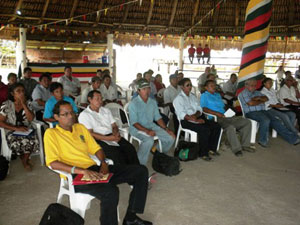INDIGENOUS leaders from Region 9 were urged by Minister of Amerindian Affairs, Pauline Sukhai to fully utilise the measures and procedures outlined in the Amerindian Act to address concerns about various issues they may have.
 On Friday, she joined Minister of Natural Resources and the Environment, Robert Persaud and officials of the Ministry’s sub-agencies at a workshop to address moving their communities forward along the path of sustainable development, especially as it relates to mining and natural resources.
On Friday, she joined Minister of Natural Resources and the Environment, Robert Persaud and officials of the Ministry’s sub-agencies at a workshop to address moving their communities forward along the path of sustainable development, especially as it relates to mining and natural resources.
“There is a full list of procedures that need to be followed by the GGMC and the Village Council also,” Minister Sukhai said at the close of the workshop at the St Ignatius benab.
She urged the community leaders to remember that their respective village councils have a key role to play in dealing with various issues and challenges that may arise. “The village council has a function to ensure that land and resources therein are sustainably used and that there is a mechanism developed for the protection and conservation of those resources.”
She noted that within the Amerindian Act, there are many guides and tools to deal with some of the concerns raised during the workshop’s interactive session. She said that if stakeholders stay true to the Act which serves as a guide with respect to land use, resources and governance issues, many of their fears would be abated.
One of the issues raised was that of the extension of the boundaries of several hinterland communities, but she reminded them that these requests were not automatically granted. “It depends strongly on the application, strongly on the justification, and when an application is made, that extension has to be investigated and validated”. A main factor during this process is the condition of occupation, she added.
Focusing on the application by the Nappi community for an extension, she said that within the LCDS agreement with Norway, finance is expected to be made available later this year, under the overseas funded Amerindian and Land Demarcation Project. “We were expecting it last year, but the combined opposition slashed it. This year, because of all the furore and chaotic issues over the budget, and the land titling exercise not being able to get going, Guyana has taken $77.8M, obtained through cuts to other institutions, to kick start this project.
The Kato issue was also addressed by Minister Sukhai. This, she said, was a case of obstruction to a claim which was approximately 24 miles upriver from the boundaries of Kato. Noting that there is a three- mile buffer zone between the community and any mining concession, she said it was the obstruction of an individual’s free passage through a public waterway that caused the case to be brought before the courts. “We have to be careful when we ask these questions. The GGMC has not issued a single block in the Kato Village that I know of, or even that the toshao knows of, or he would have complained already to me”.
The issue of titling for communities which wanted titles, such as Shiriri, which describes itself as a satellite community of Potarinau, and existing for more a century, was also addressed by Minister Sukhai. She noted that the Amerindian Act also caters for such communities that may not otherwise meet the regular requirements for becoming titled. “It says that if a village council or community council is established prior to December 31 2003, the minister may cause an order to be made and recognise you as a community council. The community council has two major tasks and that is to govern the affairs of that settlement, and once you become eligible, you can become authorised to advance your land claim; so there is in the Act a mechanism for dealing with that. Sometimes, we tend to close our eyes because we don’t want to hear about the Act because we have some preconceived notions”.
There is close collaboration among agencies which serve the ministries’ interests, and she urged community leaders to follow the procedures outlined in policy documents. Going outside of what is agreed to and expected will result in their issues taking longer to be resolved.
“Remember that it is government that has all the levels of authority to resolve issues that are affecting not only Amerindians, but all stakeholders in this country and all Guyanese”. (GINA)












